The International Space Station: life in space Understand article
How do astronauts eat, sleep and wash? Can you get ‘seasick’ in space? In the second of two articles about the ISS, Shamim Hartevelt-Velani, Carl Walker and Benny Elmann-Larsen from the European Space Agency investigate.
Life on board the Station
By Shamim Hartevelt-Velani and Carl Walker
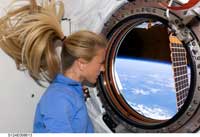
Kibo laboratory provides views
of Earth
Image courtesy of ESA
What is life like for the astronauts on board the International Space Station (ISS)? The Earth environment that most resembles the microgravity experienced on the ISS is water – which is why astronauts train in large swimming pools. Inside the ISS, astronauts can play with floating drops of water and, instead of walking, can push themselves off the walls and drift through the air.
Astronauts experience 16 sunrises and sunsets in one day, as the ISS orbits Earth every 90 minutes. This is difficult to adapt to, and they sleep an average of 5-6 hours per day instead of the 7-8 hours of sleep they enjoy on Earth. They do, however, observe a strict work/sleep schedule. Lack of sleep can, of course, be caused by the excitement of the first steps in ‘weightlessness’, the magnificent views of Earth and the darkness of the cosmos.
The crews spend around 160 man-hours per week doing scientific experiments; the rest of their time is spent on maintenance, Station control activities and spacewalks. Spacewalks (or extravehicular activities, EVAs) are necessary for construction, maintenance and for the installation of scientific components outside the Station. Sunday is generally a day of rest, although some experiments continue to run and must be monitored.
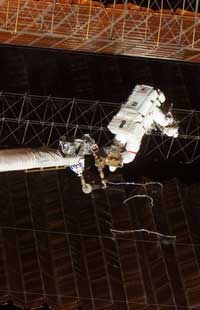
torn solar array
Image courtesy of ESA
The astronauts need to take good care of themselves on board, and their health and safety are priorities. They must be in good physical and mental condition. They eat three meals a day, and mealtimes are important for the crew to socialise. There is a kitchen area where food can be heated, a fridge-freezer and a table. There are tethers on the floor to hook feet onto, to keep astronauts in a sitting position, but often they eat while floating around. Velcro is used to secure the various food containers on the table and prevent them from floating off. Most of the food is freeze-dried, frozen, thermostabilised or ready to eat. These treatments and the conditions of ‘weightlessness’ mean that the taste of food is often impaired (somewhat like trying to eat when you have a heavy cold).
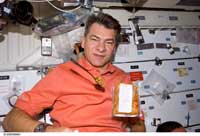
seen during a meal on board the ISS
Image courtesy of ESA
The range of nationalities on board means that the diet has to be carefully chosen. Astronauts can state their own dietary preferences before beginning their stay on the ISS, but they are free to change their minds during a mission, as long as the nutritional value (2800 calories per day) is maintained. Food is periodically delivered from Earth in cargo spacecraft (such as ESA’s ATV or Russian Progress vehicles).
There are also dehydrated foods and drinks which are reconstituted by adding water. Syringes are used to rehydrate single portions of food to avoid waste: water is a precious commodity. Transporting water to the ISS is very expensive, so some water is recycled from the cabin itself by condensation. Because water needs to be conserved, non-foaming toothpaste is preferred. Wet wipes are used for personal hygiene. Astronauts will have their first shower when they return to Earth.
There is no ‘up’ or ‘down’ in space. Sleeping involves wrapping yourself in a sleeping bag attached to the wall. The astronauts use ear plugs to keep out the noise of the life-support systems that are continuously running, as well as sounds caused by the thermal expansion and contraction of the ISS itself. They try to secure their free-floating arms, which could end up blocking the air tubes that circulate the air in the ISS and cause a dangerous build-up of carbon dioxide in one place.
The temperature is maintained at a comfortable level by the air-conditioning system so astronauts can wear light clothing. Air pressure is kept the same inside as on Earth. During launch and landing, or when performing spacewalks outside the ISS, astronauts wear special pressurised spacesuits to protect them from the extreme conditions.
The men and women chosen as astronauts work as a team. Their training helps them to cope with the lack of privacy and to be able to live in such an environment for months at a time. It becomes home for them.
Physiological effects of a ‘weightless’ environment
By Benny Elmann-Larsen, ESA Senior Physiologist
Humans and other living organisms have adapted to life on Earth for millions of years, in conditions that include Earth’s gravity (1 g), a specific temperature and humidity range, and a certain oxygen pressure. These are ‘normal’ conditions for us.
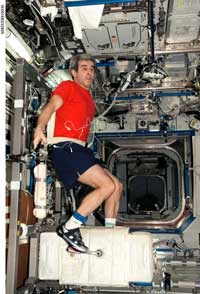
physical training in the ISS
Image courtesy of ESA
When flying out into space, we are initially exposed to greater forces during launch. Modern jet fighter pilots can often be exposed to around 9 g (compared with 4 g during the Space Shuttle launch), which is considered the limit for what the human body can sustain for some seconds without harm.
On Earth, gravity helps us to tell what is up and down, and to feel if we are moving. The sensors in our balance and movement system (in particular the inner ear and eyes) use gravity as a reference. On an orbiting spacecraft, the lack of gravity makes it difficult to tell what is up or down.
During the first hours or days in ‘weightlessness’, astronauts often encounter a mismatch between sensors in their balance system, which coordinate inputs from their eyes and inner ears (registering movement and velocity) and from joints and muscles. In many astronauts, this causes something similar to motion sickness on Earth – which is also caused by confusion in the balance-movement-vision system. The astronauts feel unwell and nauseous until their body has ‘learned’ the new rules, i.e. has reprioritised the different nerve signals. Eventually, a stable condition is achieved in which the astronaut’s visual input becomes dominant.As the normal effect of gravity disappears in the spacecraft, everything in the body that is commonly influenced by gravity behaves differently as well. The loading of the bones is different since the skeleton does not have to carry a bodyweight, and the muscles have a much easier task moving the astronaut around.
The movement of blood in the circulatory system is also affected in space. The heart is a pump and a muscle at the same time: the muscle contractions push the blood around the body, and this circulation (which is influenced by gravity) ensures that the pump always has a supply of blood to move. If the return of blood to the heart is insufficient, it will pump smaller and smaller volumes, and eventually collapse.
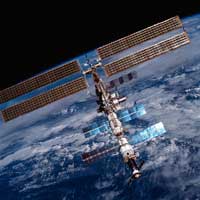
Image courtesy of ESA
What happens to the circulatory system in space is similar to what happens if you lie down on Earth. The circulation works best at a certain blood pressure (which is why we can have problems if our blood pressure is too high or too low). When we lie down, blood returns to the heart more easily, so the heart does not need to pump as hard as when we are standing. If the circulatory system did not adjust to this new situation, blood pressure would increase. Therefore the arteries in the systemic system (carrying oxygenated blood from the heart to the rest of the body) relax, enabling the blood to flow with less overall resistance and returning the blood pressure to normal. When the heart fills with blood (diastole), the heart muscle relaxes more than it does when we are standing, resulting in a larger volume of blood being pumped per beat, but with fewer beats per minute.
This is very similar to what takes place when astronauts first enter weightlessness: the lack of gravity means that blood returns more easily to the heart – reducing the need for forceful pumping – and also shifts from the astronauts’ legs into their chests and heads. Their faces tend to become puffy and their sinuses swell. This fluid shift initially increases the blood volume as more water enters the blood stream – mainly from the tissues in the legs. This extra water in turn thins the blood to some extent and, after a few days, the kidneys start to excrete more salt and water, to mimic the normal situation on Earth. Although the slightly puffy heads and stuffy sinuses may remain, the situation improves after the first few days.
(This process starts on the launch pad if the astronauts have to wait in their seats, lying on their backs, for two hours or more. When they finally get out of their seats in orbit, there is often a queue for the toilet!)
Upon return to Earth, gravity will pull those fluids back down into the legs (pooling) and away from the head, which could cause the astronauts to feel faint when they stand up. But as they also begin to drink more, their fluid levels return to normal in a couple of days.
Finally, what makes an astronaut put up with the danger, the ‘spacesickness’, the cramped conditions and the lack of privacy? Science in School asked German astronaut Thomas Reiter.
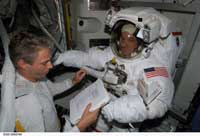
NASA astronaut Jeff Williams with his
spacesuit, preparing for an extravehicular
activity
Image courtesy of ESA
“[Being an astronaut] was a dream I had as a child. I followed all the space activities when I was six, seven, eight years old. When I was 11, I watched the first Moon landing. Even then, I dreamed of becoming an astronaut. At the time, getting into this profession was not very likely in Europe, but I was lucky. When there was a selection process – in 1986, I think – I was just the right age and had the right prerequisites. I didn’t think twice about whether I should take part. And it worked out!
“The most exciting moments are certainly the launch and doing an extravehicular activity…. It’s really very, very exciting and everyone who has the chance to be up there looks forward to leaving the Station for a few hours at least. There are interesting moments inside as well, catching beautiful views of the Earth or of the starry sky. And there’s the re-entry. Those are the main highlights from a personal, emotional point of view.”
Resources
- For the first of the two ISS articles, see:
- Hartevelt-Velani S, Walker C (2008) The International Space Station: a foothold in space. Science in School 9: 62-65.
- For the complete interview with Thomas Reiter, and other related articles from Science in School, see:
- Warmbein B (2007) Down to Earth: interview with Thomas Reiter. Science in School 5: 19-23.
- Wegener A-L (2008) Laboratory in space: interview with Bernardo Patti. Science in School 8: 8-12.
- Williams A (2008) The Automated Transfer Vehicle – supporting Europe in space. Science in School 8: 14-20.
- Many hundreds of images, videos and animations about human spaceflight are available on the ESA website: www.esa.int/esa-mmg/mmg.pl?collection=Human+Spaceflight and can be used for education purposes.
- ESA has produced many educational materials relating to the International Space Station (ISS):
- A printed ISS Education Kit for both primary- and secondary-school teachers is available in all 12 ESA languages. The kits are based on all the fascinating activities involved in building, working and living on-board the ISS, and provide background information and exercises for classroom teaching. They are available to all school teachers in ESA member states and can be ordered free online: www.esa.int/spaceflight/education
- An interactive version of the ISS Education Kit is available for everyone at www.esa.int/spaceflight/education
- A series of ISS DVD lessons covers topics relating to European school curricula. These are based on Project Zero Gravity and there are four in the series. The latest, Space Robotics, is now available to all school teachers in ESA member states and can be ordered free online: www.esa.int/spaceflight/education
- A new DVD on the physics involved in the Automated Transfer Vehicle (ATV) is due to be released in 2008. DVDs can be ordered free by teachers: www.esa.int/spaceflight/education
- ESA is also developing a series of online lessons for primary- and secondary-school students and their teachers. See: www.esa.int/SPECIALS/Lessons_online
- A new Space Exploration Kit 1 for primary schools will be released in 2008.
- Further details and education materials:
- ESA Education website: www.esa.int/education
- ESA Human Spaceflight Education website: www.esa.int/esaHS/education.html
- As part of the International Astronautical Federation’s 2008 symposium, Celebrating Ten Years of the International Space Station, a panel of ISS crew members answered school-students’s questions about living and working on the ISS. The video can be watched online: www.iafastro.org/index.php?id=541





